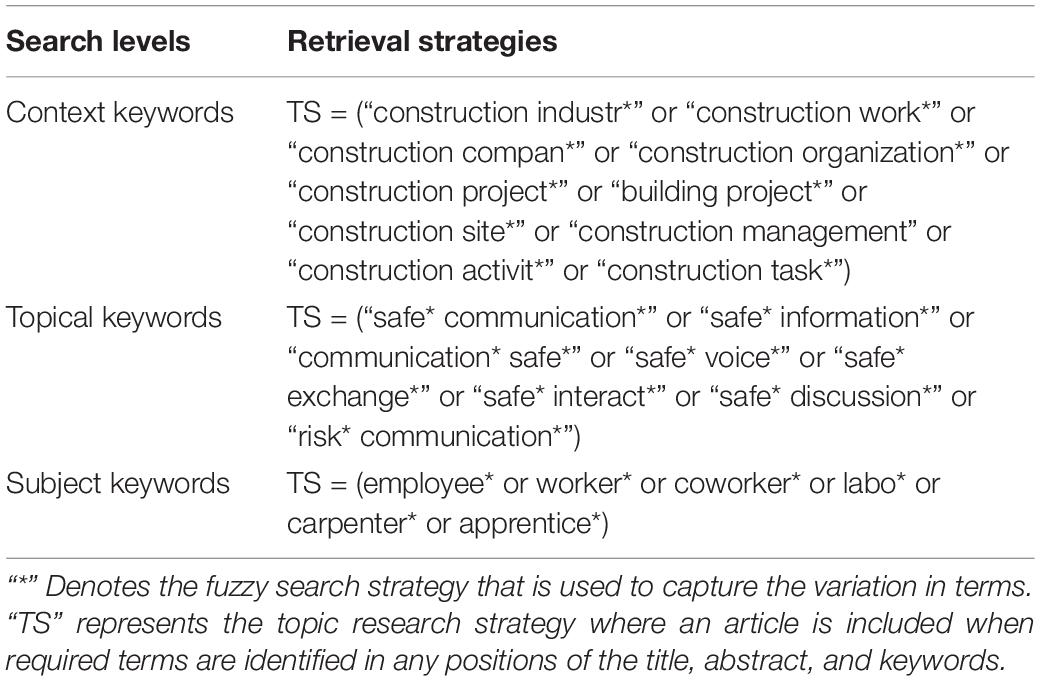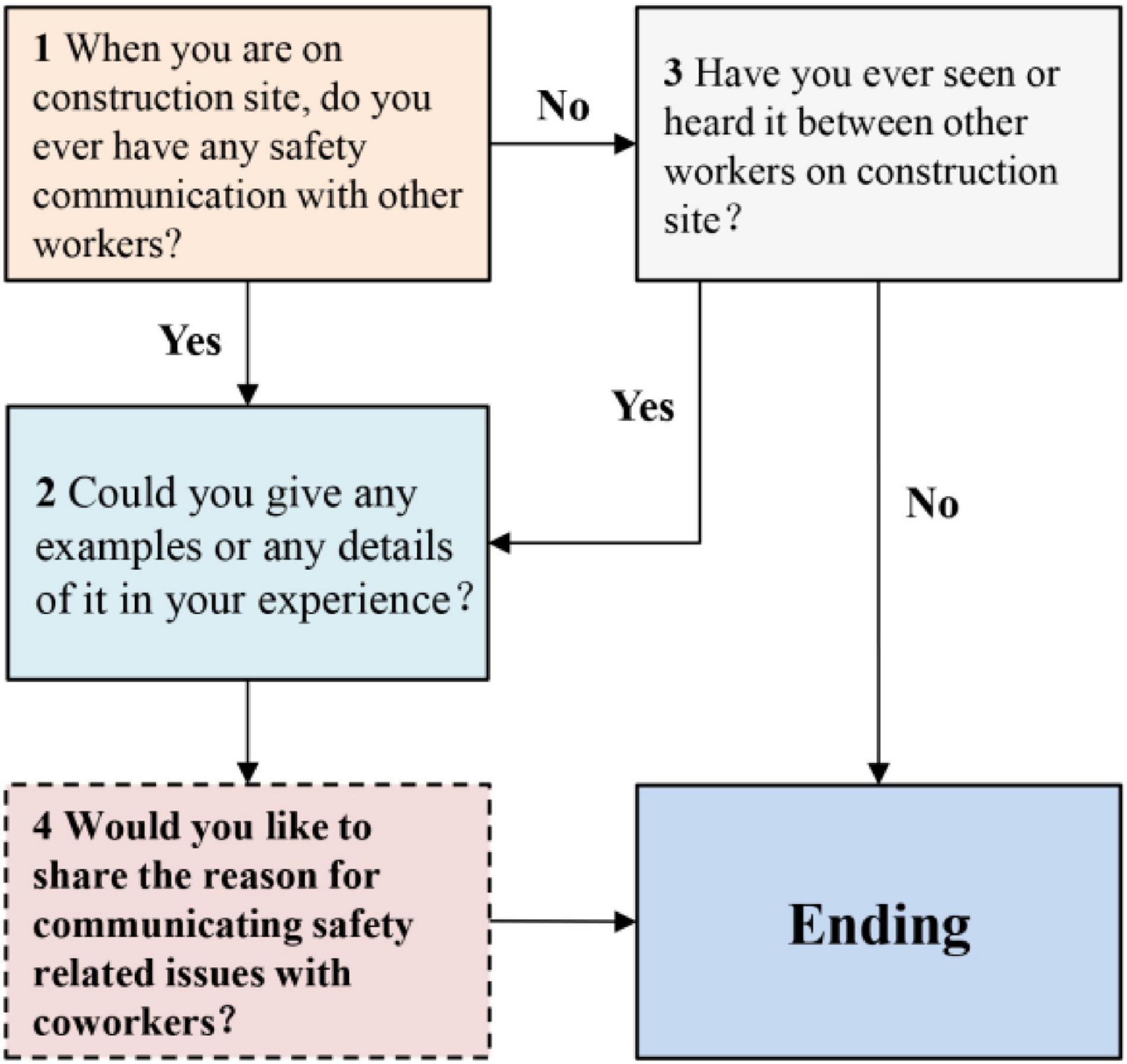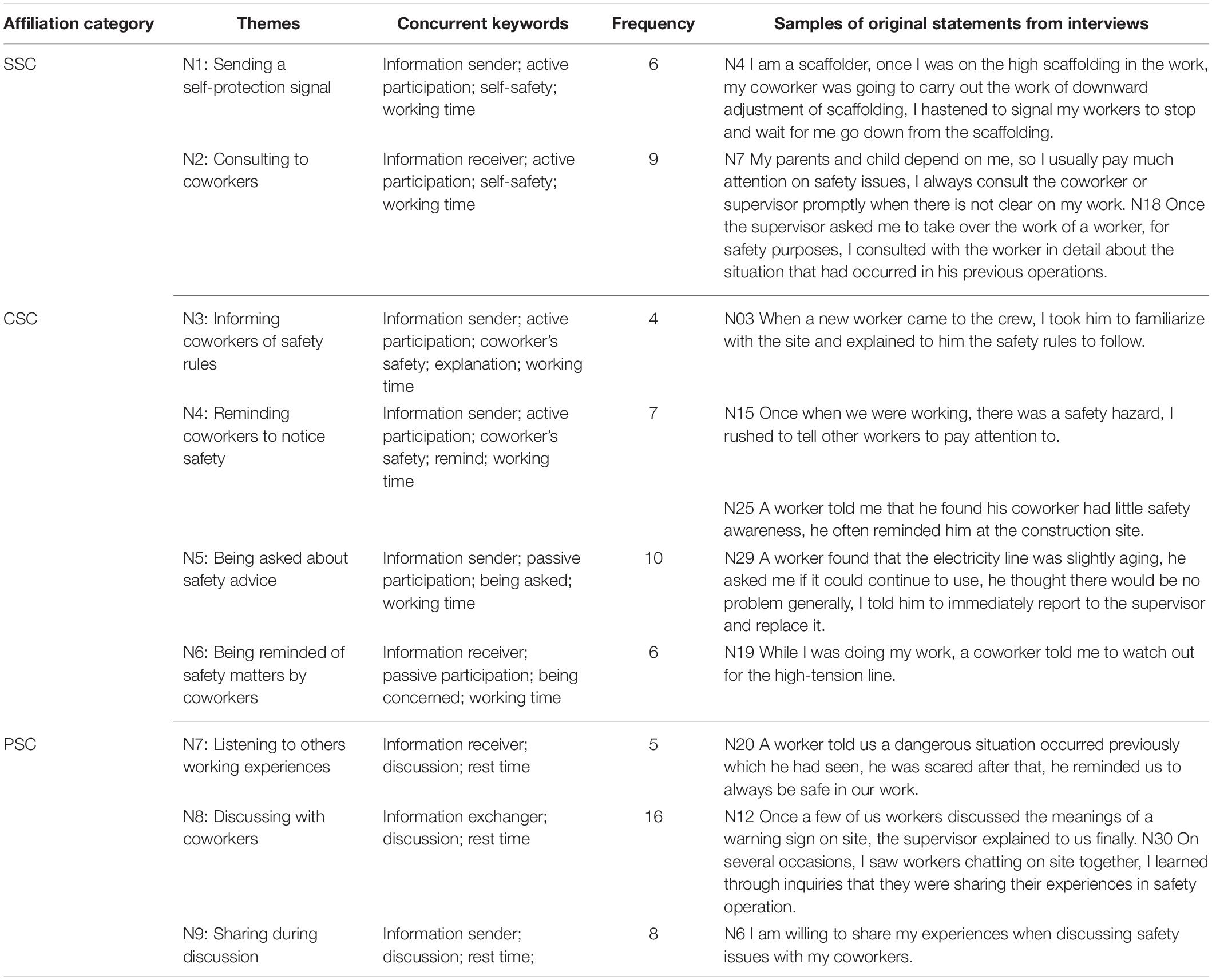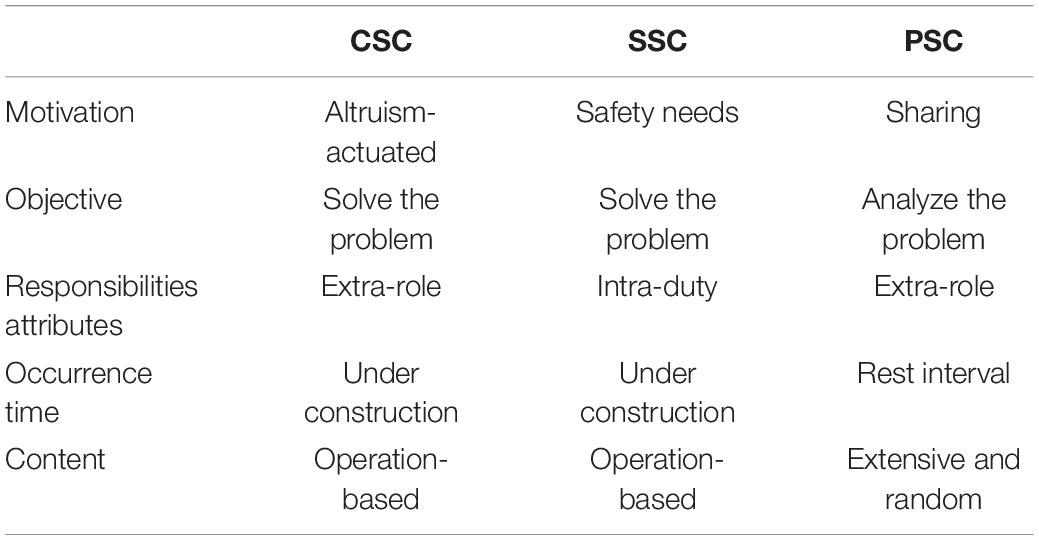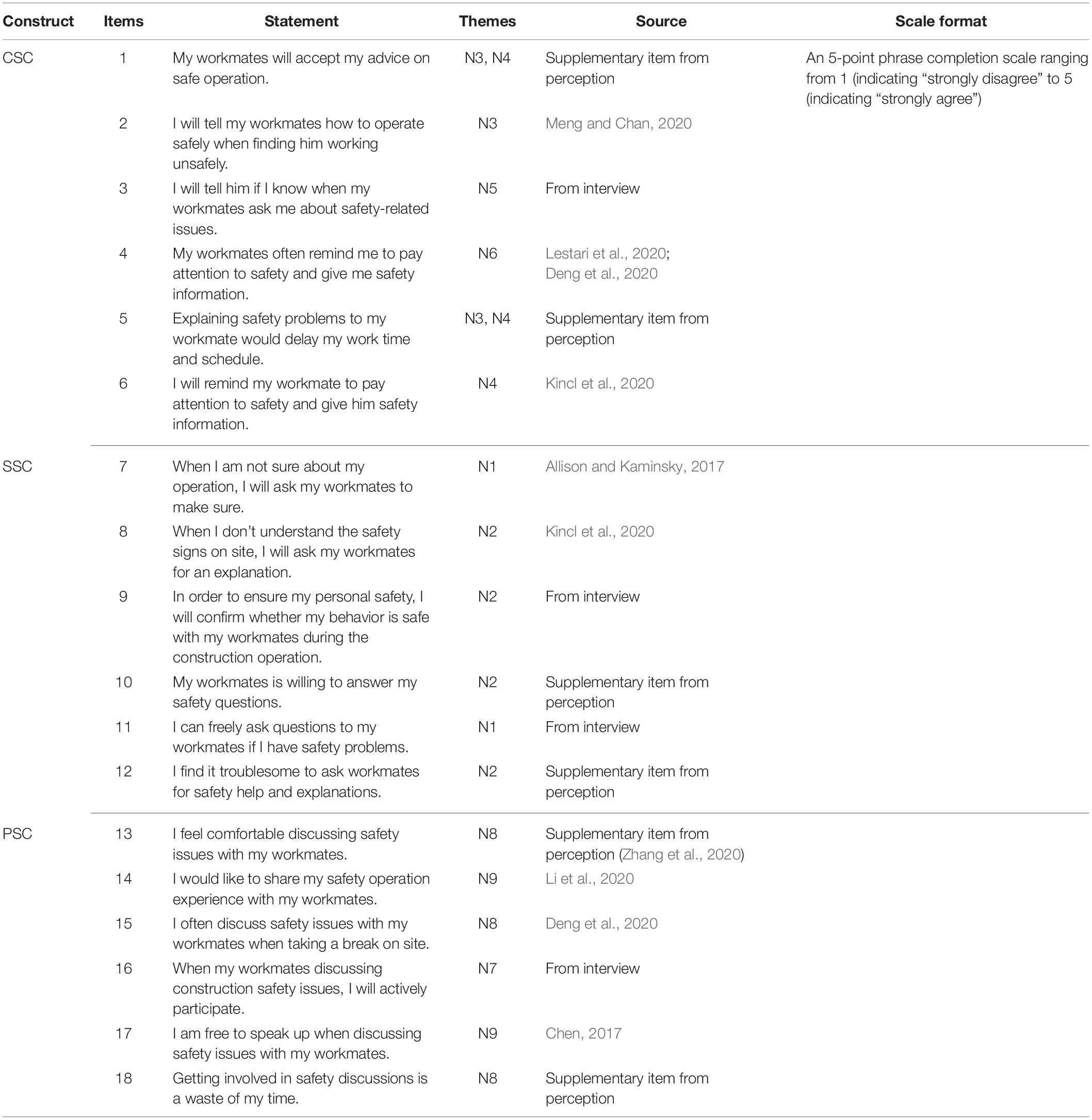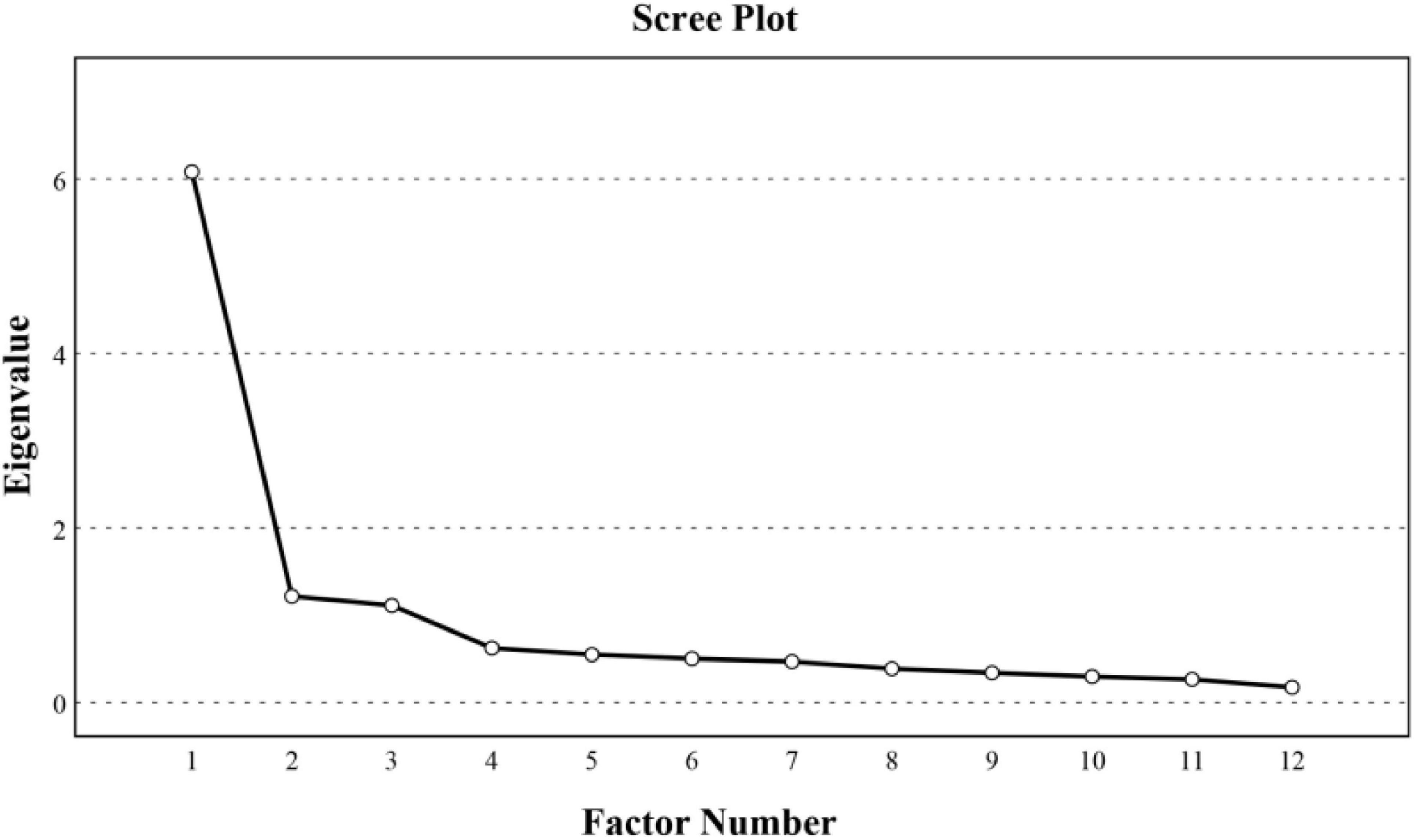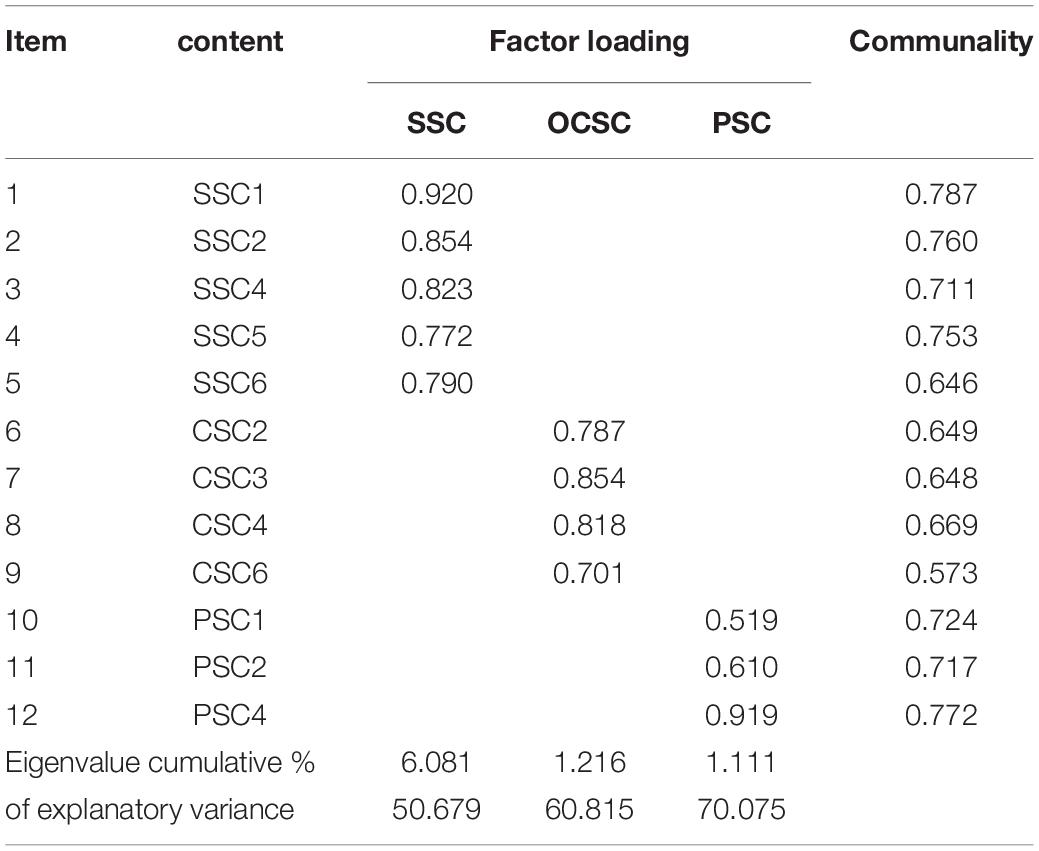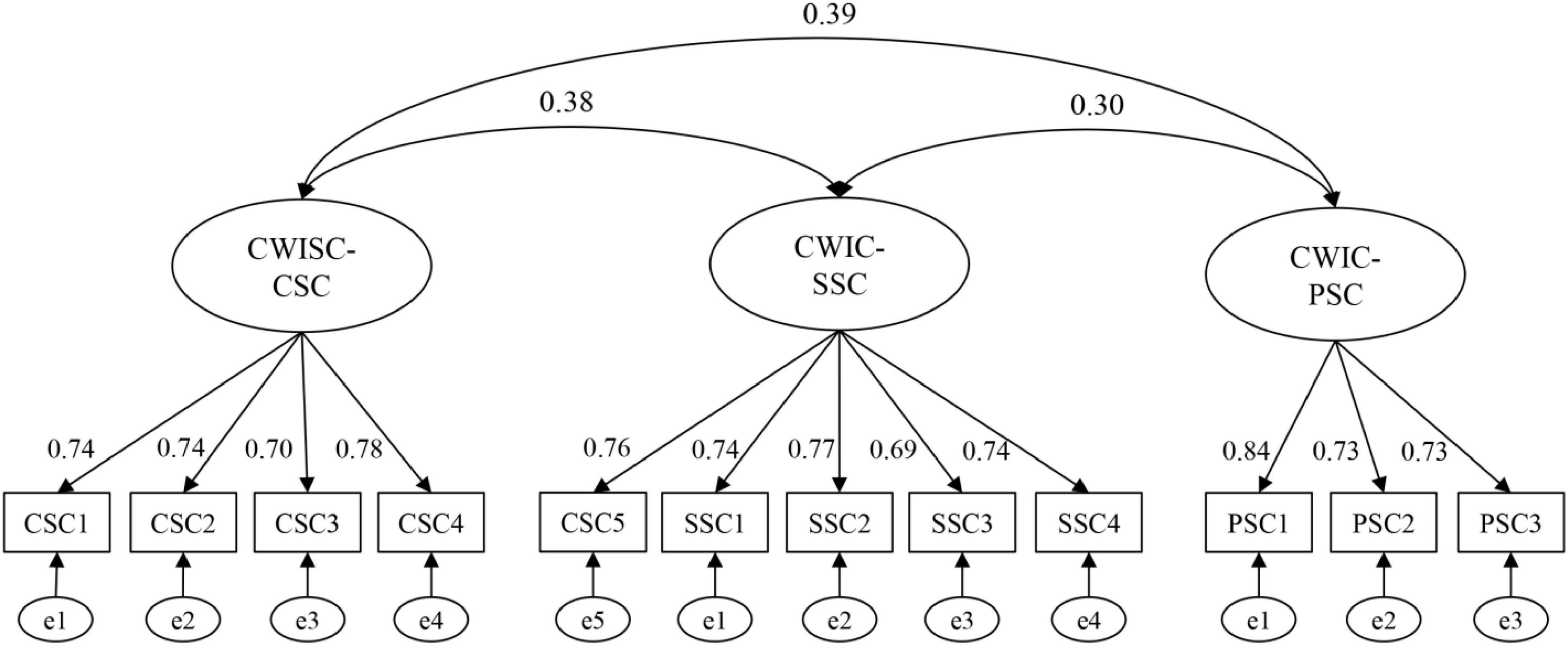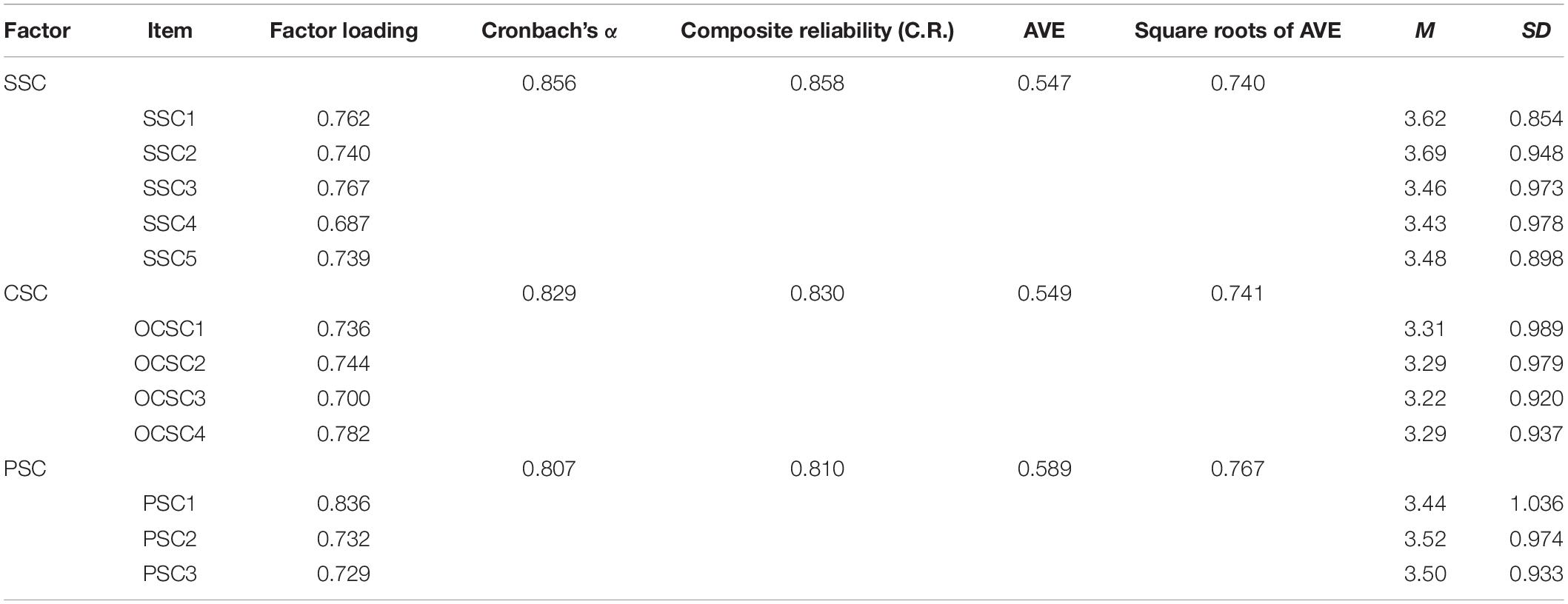- 1School of Civil Engineering, Harbin Institute of Technology, Harbin, China
- 2School of Management, Shandong University, Jinan, China
- 3School of Economics and Management, Beijing Jiaotong University, Beijing, China
- 4School of Civil Engineering, Northeast Forestry University, Harbin, China
Existing studies have highlighted the importance of informal safety communication among workers at construction sites. However, there is still a lack of empirically tested theoretical models with valid and reliable scales for describing and measuring construction workers’ informal safety communication (CWISC). Accordingly, this study aimed to fill this need by developing an instrument to assess the communication performance of construction workers. Four stages of scale development were described: construct formation, item generation, factor extraction through the exploratory factor analysis (EFA) (n = 219), and scale assessment through the confirmatory factor analysis (CFA) (n = 156). Using questionnaire data drawn from construction workers in China, the CWISC was verified to be a three-dimensional construct including citizenship safety communication (CSC), self-needed safety communication (SSC), and participatory safety communication (PSC). The corresponding CWISC scale with 12 items was shown to have acceptable internal consistency reliability, as well as content, convergent, and discriminant validity. The CWISC scale could serve as an instrument to assess and identify the weaknesses in informal safety communication performance of construction workers. In turn, this information could help supervisors implement appropriate management practices to those workers to enhance workplace informal safety communication. Related studies taking a multidimensional CWISC into account were expected to be carried out.
Introduction
Despite constant efforts for safety management over the past few decades, construction safety has not been improved as much as compared to other industries, it still witnesses a high rate of accidents (Zaira and Hadikusumo, 2017; Liang and Zhang, 2019). From the perspective of accident investigation, workers’ unsafe behaviors were identified to be the primary and immediate cause of accidents considering that nearly 80% of on-site accidents were caused by unsafe human behaviors (Choi et al., 2017; Li et al., 2017; Zhang et al., 2019). Continued efforts to deepen understanding and decrease unsafe behaviors are still urgently needed.
Safety communication has been regarded as potential intervention for construction workers’ unsafe behaviors (Cigularov et al., 2010). It is not just a process of exchanging safety information and knowledge at the workplace (Liao et al., 2014), but involves effects on workers’ behaviors and their perceptions of safety (Shuen and Wahab, 2016). Safety communication was discussed in many studies for its significant potency in high-risk work environments (Zohar and Luria, 2003; Chan et al., 2016; Albert and Hallowell, 2017). From the perspective of information flow, safety communication can be carried out in three directions, upward, parallel, and downward (Yates and Orlikowski, 1992). Considering the role played by it in these situations, when detecting potential hazards and learning specific safety rules to adhere (Parker et al., 2001; Shuen and Wahab, 2016; Pandit et al., 2020), improving safety communication was suggested to be an essential measure in achieving fewer safety incidents on job sites (Vecchio-Sadus, 2007; Kines et al., 2010; Liao et al., 2014). Workers constitute the largest group on construction sites, and homogeneity of their identities reasonably increases the tendency of safety communication within crews (Turner et al., 2010; Allison and Kaminsky, 2017). Parallel safety communication, an action between subjects with the same position, was more likely to promote safety behaviors compared with leader–worker interactions (Zhou et al., 2008; Lingard et al., 2019). Given that the importance of leader–worker safety communication had been supported and highlighted in existing studies (Huang et al., 2018; Su et al., 2019), parallel safety communication between workers needs more attention.
The communication structure of a successful organization should include both formal and informal communication. Construction workers’ informal safety communication (CWISC) was defined as safety-related information sharing through channels outside pre-established structures of an organization (Alsamadani et al., 2013). It is a personal activity held at work place with no arranged agenda, and takes the typical form as an impromptu safety conversation based on the current exposures that may be urgent and alarming (Tang et al., 2015). Specific dialog situations can be “A worker passes by another worker and reminds about a past hazardous event to avoid its reoccurrence,” and “A worker asks another worker for advice on safety operation.”
In contrast to formal safety communication preplanned at a fixed time as pre-construction safety trainings or toolbox talks (Rajendran et al., 2009; Hallowell, 2012), CWISC provides a more flexible channel, which is not limited by time and place, this preponderance contributes to convey safety information in a timely manner (Wu et al., 2017). When workers are caught in information ambiguity triggered by perceived risks in the process of operation, the action of seeking safety information from coworkers leads them to respond safely. The importance of CWISC has solicited attention from scholars in safety research areas, a few attempts were made to explore its characteristics and impacts on safety performance. According to a comparative research on the social network conducted by Alsamadani et al. (2013), the crew in which workers had numerous informal safety communication links presented a lower injury rate, and the closely linked crew showed an increased capacity to manage potential errors before they lead to an incident (Alsamadani et al., 2013). Further, using a modified questionnaire developed by Alsamadani et al. (2013), Allison and Kaminsky (2017) reported that workers in mixed-gender crews relied more heavily on informal communication for their safety information (Allison and Kaminsky, 2017).
Although the importance of CWISC in construction safety has been recognized, its core characteristics remained unclear, a lack of a well-designed (i.e., reliable and valid) measurement for assessing multidimensional CWISC was observed. In most existing studies, the existence of different channels (formal and informal) had been recognized, but they did not make a distinction when measuring it. For instance, Pandit et al. (2020) introduced both formal and informal safety communication among construction workers, but then all of these descriptions were reclassified into “safety communication” to be measured (Pandit et al., 2020). Limited studies focusing on measuring CWISC employed the method of social network analysis (SNA), which was argued to be inaccurate and error-prone (Fischbach et al., 2009), remained a vacancy in the measurement scale. In addition, practices of different types of CWISC were available in recent studies. Allison and Kaminsky (2017) described CWISC as “calling friends in another crew on how to handle a work problem” (Allison and Kaminsky, 2017), while Kaskutas et al. (2016) gave an example of it as “teaching dialog between experienced workers and other workers” (Kaskutas et al., 2016). The purpose for initiating the aforementioned safety communication was obviously different; nevertheless, the CWISC was generally treated as an unexpanded variable, and the categories and corresponding motivations of it remained unclear.
Being one of the exploratory studies on this issue, this article aimed to give a particular focus on identifying specific dimensions of CWISC and develop a well-designed instrument to describe and assess it. The research drew upon the insights of the safety communication literature, and engaged in a four-stage process to systematically explore and examine the measurement scale.
The Present Research
The goal of this research is to construct and validate an efficient measuring tool of CWISC capturing different dimensions. To reliably and accurately assess a theoretical construct, a systematic and rigorous process of development and validation should be followed (Farooq, 2016; Kim et al., 2021). A deductive–inductive approach with mixed methods (qualitative study and quantitative study) was applied to study the issue, by which both summative derived categories and those correlations randomly arisen from data may find their way into this study (Itzkovich, 2021). The approach was appropriate as there was little theory to guide notions about specific forms of CWISC (Yang et al., 2018).
For the development of a framework and the corresponding scale of CWISC, four activities were conducted with the help of voluntary construction workers in China; namely, construct formation, item generation and content validity assessment, exploratory factor analysis (EFA), and confirmatory factor analysis (CFA). The overall flow with relevant methods and specific contents embedded in the research was illustrated in Figure 1.
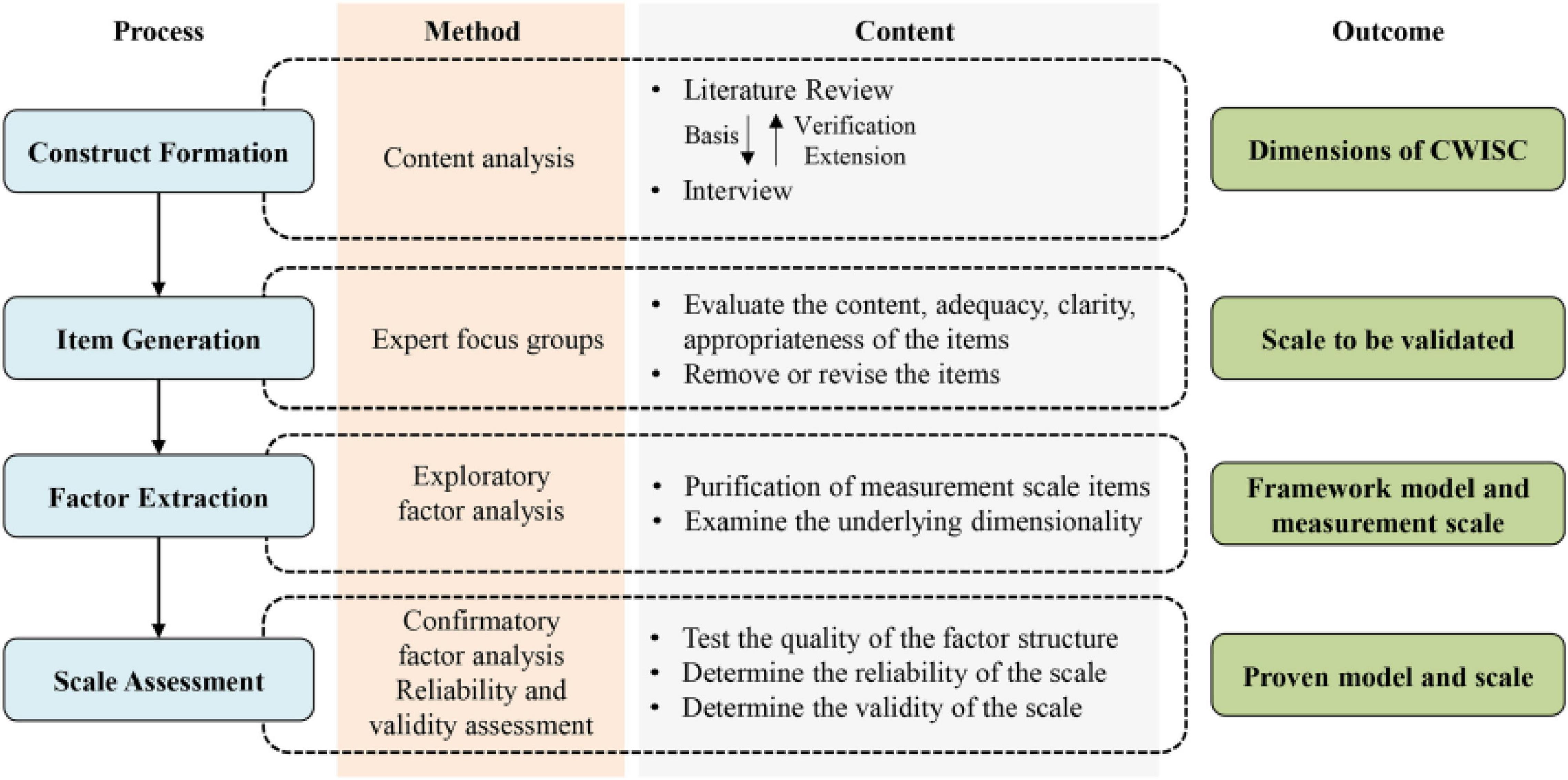
Figure 1. Development process of the construction workers’ informal safety communication (CWISC) scale.
Study 1
Methods
Literature Review
Literature review, one of the qualitative research methods, was first applied to broaden insights into CWISC. Through a holistic summary, potential compositions of the construct can be used as a starting point to clarify the focus of the next stage. In this process, practices of safety communication and descriptions of related theories were collected from an open resource, then a series of pre-established categories were proposed (Hinkin, 1998; Yang et al., 2018).
Based on a systematic analysis of the potential terms, a three-level keyword structure, adaptively modified from Liang’s search strategy (Liang and Shi, 2021), was adopted to cover diverse and large-scale search terms for comprehensively and reliably obtaining CWISC-related articles (as shown in Table 1). The context keywords defined the search context, which was limited to the construction industry; the topical keywords further narrowed the search scope; and the subject keywords limited the search subject to construction workers.
The Thomson Reuters’s Web of Science (WoS) core collection database was selected because it is a source of standardized and high-quality academic publications. By restricting the literature type to article, a total of 78 candidate articles were obtained. To further eliminate the literature outside the target topic, abstracts were screened seriatim according to the criterion of minimizing information missing. After a careful screening process, a total of 37 CWISC-related articles were identified for the following literature review. The literature excluded involved the following themes: the development and application of emerging safety-related technology (BIM, virtual reality, wearable devices), safety communication in other industries, and safety communication between other participants (leaders and workers, management departments).
Semi-Structured Interviews
Participants
Recorded documents, participative observation, and interviews are all typical methods for obtaining data in qualitative research. However, workers’ safety communications on construction sites are normally not recorded by the organization, and remote participative observation has limited access to the specific content of communication. Given this, semi-structured interviews were selected to excavate exact communication performances.
A number of semi-structured interviews to safety managers from several construction projects and workers within their jurisdiction were carried out in person, then a match between theoretical literature and practical conditions was checked to further bridge the gap. In total, 26 workers participated in the interview voluntarily from March 2021 to April 2021. To reduce self-reporting and recalling biases of workers, three safety managers and five supervisors, each with more than 5 years of safety management experience, were also invited to interview. Face-to-face and online interviews were selectively applied according to a comprehensive consideration of geographical accessibility and participants’ wishes.
Procedure
Before interviews, CWISC was introduced to participants to give them a clear understanding about the concept, the action intensified the compatibility and validation of answers. Abide by the semi-structural interview syllabus, questions were executed in accordance with the following designed process (Figure 2). In addition to questions about workers’ performances during safety communication, the reasons for carrying out or engaging in these activities were further explored. Open-ended questions were given to workers who have participated in safety communication. The significance of CWISC was affirmed by workers as the interactive process helped them understand safety rules better and behave in a safe manner.
For the interviews to safety managers and supervisors, they were asked for comments on workers’ performances: “Are there private safety communication between workers on construction sites? Could you tell us any details of it?”
Analysis
Transcription and analysis of interview recordings were performed by three researchers who mastered the content analysis method. After eliminating ambiguous and irrelevant responses, the following steps were adopted to obtain final classifications. First, keywords were extracted and marked from descriptive texts of safe communication performances and motivations. Then, these keywords were categorized into different themes and further matched with the initial types derived from the literature, this step continued until no matches emerged. Finally, the characteristics of the remaining unclassified themes were summarized and discussed to define new types.
Results
Preliminary Classification From a Literature Review
In terms of research paradigms and method applications, prior studies associated with workers’ safety communication can broadly be split into two categories. The first embranchment took the communication social network as the primary research object, and comparative analyses were carried out to identify correlations between social network characteristics with specific safety performance [i.e., hazard recognition skill (Pandit et al., 2020) and safety climate (Lingard et al., 2019)]. The second embranchment presented empirical studies into safety climate and safety citizenship behaviors (SCB) within workgroups, aiming to reveal a causal mechanism with other organizational and individual indicators (Meng and Chan, 2020; Zhang et al., 2020). Within these studies, workers’ safety communication behaviors were involved in subdimensions of the first-order construct. Surprisingly, empirical studies closely related to CWISC were relatively scarce.
Focusing on the collation of descriptions and measurements, valuable clues had emerged during the extraction process. Firstly, in terms of social network analyses, participants were commonly invited to fill in the names of workers with whom they exchange safety information, together with choosing options on different frequencies and modes, in which informal safety discussion and formal safety exchange (training, toolbox talking, and written communication) were, respectively, installed (Alsamadani et al., 2013; Kaskutas et al., 2016). Secondly, in the domain of safety climate, safety communication was considered to be one of the explanatory indicators of safety climate. Specific communication behaviors were adopted to directly measure the unidimensional safety climate or assigned to a subscale, sample items were “Coworkers remind each other to take precautions” (Zhang et al., 2020) and “Safety issues are openly discussed between my supervisor and my workgroup” (Beus et al., 2019). Further, similar items were applied to measure safety voice behavior, which was widely acknowledged as a subdimension of SCB. Safety voice was defined as an active behavior making constructive suggestions related to safety concerns (Yang et al., 2018). Typical descriptions were “I tell my colleague who is doing something unsafe to stop” and “I discuss new ways to improve safety with my colleagues” (Tucker et al., 2008).
Obviously, the aforementioned safety communication under different interests was endowed with diverse interpretations. Due to the lack of a clear CWISC concept, the understanding of CWISC remained scattered and its subdimensions have not been fully expanded. Facing this challenge, two categories were aggregated grounded in analyses on the intention of communication. “Interpersonal helping,” borrowing from Yang’s definition, was used to describe the communication with helping intention (Yang et al., 2018), while “Safety discussion,” drawing on the mentioned keyword, referred to the communication with an intention of sharing information. Typical statements were sorted as shown in Table 2.
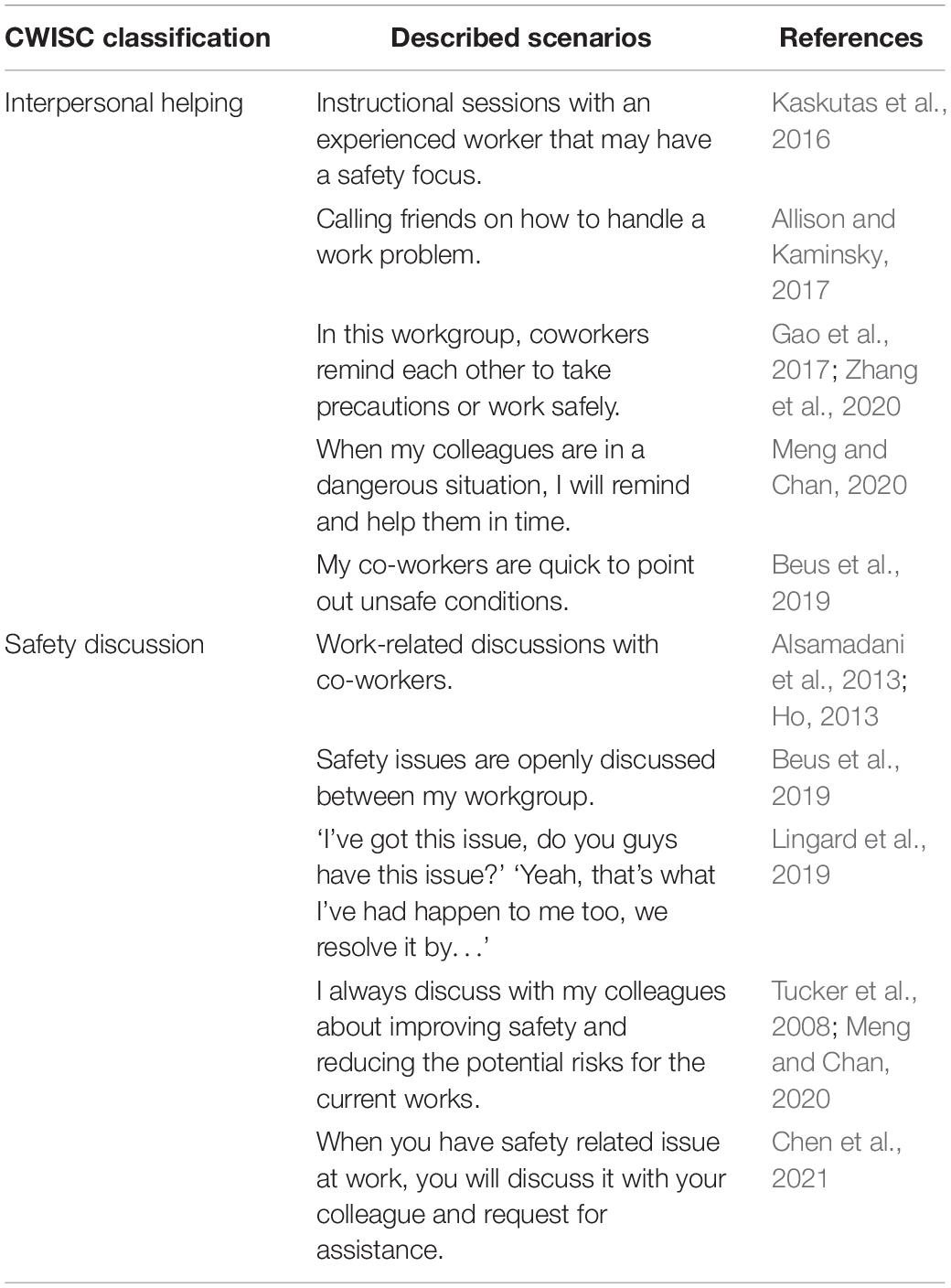
Table 2. Preliminary classification of construction workers’ informal safety communication (CWISC) from the literature.
Construct Formation
Given the greater amount of colloquial expressions, much time was spent on transcribing and summarizing the main ideas of workers. After removing ambiguous descriptions, such as communication actions with indeterminate time and place, the results of interviews came in the form of a 28,000-word interview record and 71 CWISC events. Keywords were summarized and marked to identify the initiator of the communication, the sender, and receiver of the information, the time, and purpose of the activity and the feeling of the communication, this process was conducted by taking the sentence as the unit of analysis. Considering that safety communication activities generally include basic elements, such as communicator, communication time, and safety information, a single keyword cannot be used as the basis for the identification and classification of safety communication activities, but a combination of keywords within a statement. Then, based on the keywords, 9 themes were generated and categorized into subdimensions of CWISC, the cumulative results of coding for CWISC were shown in Table 3, the results were verified, the proposed two types of CWISC were enriched, and further a third type was developed.
Because there was a lack of sufficient understanding on CWISC, the original name of aforementioned dimensions was drawn on keywords of existing studies. With the in-depth investigation of workers’ performances and corresponding motivations, a rational perspective was expected to be followed so that they can be normatively and synchronously renamed. Intrinsic motivation, reported as a critical predictor of behaviors, was employed as a principle of naming. Finally, safety communication represented by “safety discussion” was categorized as participatory safety communication (PSC); citizenship safety communication (CSC) was used to summarize communication behaviors for the purpose of “interpersonal helping”; self-needed safety communication (SSC), a newly developed category, included communication behaviors of seeking self-protection.
Citizenship Safety Communication
In this study, the concept of CSC was first introduced for those altruism-based communication phenomena on construction sites. Similar to the definition of SCB, CSC refers to extra-role safety information exchange through informal channels. It focuses on improving coworkers’ safety performances beneficial to coworkers and organization. Four detailed themes were gathered from interviews, they were “Informing coworkers of safety rules,” “Reminding coworkers to notice safety,” “Being asked about safety advice,” and “Being reminded of safety matters by coworkers.” Further, CSC accounted for 27 out of total 71 events, “Being asked about safety advice” was the most mentioned scope. Of the 27 reported CSC events, 11 were related to the active helping behaviors of communication initiators. In addition, workers reported some communication activities that were not originated by their own. In total, 10 workers claimed that they had been asked by fellow workers to confirm if the operation was safe as well as to explain the safety signs to coworkers.
Two characteristics of CSC were revealed through interviews. The first characteristic stresses its intrinsic altruistic motives of individuals, worrying about the potential injury of coworkers acting as a promoter for originating or participating in CSC. The second characteristic emphasizes that it is a discretionary positive act outside workers’ responsibilities. Supervisors had made it clear that such helping behavior was encouraged but not prescribed, it would not be rewarded by the organization.
Self-Needed Safety Communication
The second type was SSC: help-seeking information exchange sought to ensure sponsor’s own safety. During interviews, some workers pointed out the straightforward reason for taking SSC as they needed to keep themselves safe on worksites, which appeared to be an essential characteristic of SSC. Two themes under SSC were motivated by the worker’s safety need; they were “Sending a self-protection signal” and “Consulting to coworkers.” SSC accounted for the least among the three communication behaviors, with only 15 events reported. Of the 15 reported SSC events, 9 were related to “Consulting to coworkers,” others were “Sending a self-protection signal.” These two themes represented different safety information flows. Behaviors of “Sending a self-protection signal” were accompanied by the sending of safety messages, whereas actions of “Consulting to coworkers” were expected to receive safety information.
Compared to the extra-role altruistic features of CSC, SSC is an intra-duty action that workers should perform to achieve their own safety. This important point of view emerged from the explanations of supervisors. They claimed that the organization had provided workers with the necessary safety training and protective equipment; in return, workers were given the responsibilities and obligations to operate in a safe manner. They should take positive actions to achieve safety goals, not only for the organization, but also for themselves.
Participatory Safety Communication
The third type, PSC, describes safety communication for the purpose of sharing and exchanging safety-related information. Specific themes were “Listening to others working experiences,” “Discussing with coworkers,” and “Sharing during discussion.” There were totally 29 events associated with PSC, which was the most common form of CWISC.
Some distinguishing features of PSC were generated corresponding to the other two types of CWISC. PSC is first labeled by its analysis-oriented function compared to solution-oriented function of CSC and SSC. The focus of such an action is to share and exchange information with coworkers, it is about their own understanding of safety without an mixed intention for improving their own and their coworker’s safety immediately. As workers described, they mostly carried out PSC during the rest time. The second characteristic stresses the dynamicity of the interactive process, in which the worker can act as both the sender and receiver of safety information.
Summative Comparison of Three Subdimensions
These three types of CWISC provided access to transmission and sharing of safety information between workers on construction sites. As communication is a process that requires the involvement of more than two individuals, it can be defined as different types according to motivations of participants. The following scenario is a common communication process, when worker A asks worker B for advice on how to operate in a safe manner, and worker B gives a detailed explanation. Defined from the motivation of A, he initiates SSC, whereas in terms of B, he participated in the CSC passively. A pertinent summarized comparison of the three subdimensions was presented in Table 4 for legible understanding.
Study 2
Methods
Procedure
This study followed Evans’s procedure of developing measurement items (Evans et al., 2007), the process of identifying scale items began by reviewing items used in previous measures of SCB, safety climate, and safety voice. Items that were applicable to the themes established earlier (N1–N9) were selected. Some items were included without a change, others were slightly modified to adapt to the construction background. Then additional items were written from interviews to fill in the themes that have not been populated. Items were designed to be general to apply across different trades. An example of a “general” item was “I can freely ask questions to my workmates if I have safety problems.” An example of a “specific” item was “I can freely ask questions to my workmates when I do not know the right place to start taking down scaffolding.” Further referring to the study of Zhang et al. (2020), items of communication perception were used in their study to measure safety communication between the supervisor and workers, sample items were “I feel that my supervisor encourages open communication about safety.” and “I feel comfortable discussing safety issues with my supervisor.” Then, in this study, supplementary items of communication perception (both forward and reverse items) were designed within each subdimension, these descriptions were derived from workers’ viewpoints.
For the exploration of the extent to which the content domain of interest can be reflected by specific set items above, content validity of the initial CWISC scale was evaluated over two rounds. Both item- and scale-level content validity appraisal procedures were executed by a group of six experienced occupational safety experts (Polit and Beck, 2006; Man et al., 2019). The expert panel consisted of one woman and five men, of those, four worked in university, three worked in construction companies. In particular, one had a background in both university and construction company.
Analysis
After reviewing the items in first ground, experts were invited to rate each item on its relevance to the affiliated CWISC dimension with four grades (1—not relevant, 2—somewhat relevant, 3—quite relevant, and 4—highly relevant) (Polit and Beck, 2006). Concisely, the score represented its explanatory ability of the default dimension. The item with insufficient agreement on its relevance will be recorded. In second ground, a focus group discussion was implemented to revise items through supplementing, removing, and modifying. These two steps were repeated until all items passed the relevance assessment.
Content validity index (CVI) was the most widely reported approach in scale development studies (Zamanzadeh et al., 2015). According to Polit’s and Beck (2006) recommendation, item-level CVI was calculated as dividing the number of experts giving a rating of either 3 or 4 on one item by the total number of experts, while scale-level CVI was determined by the average of CVI of all items in the scale (Polit and Beck, 2006).
Results
Based on the literature review and clues from interviews, the layout of total 22 communication scenarios was installed as the initial scale. These items were the description of representative behaviors, they were as general as possible to ensure that workers of various trades were likely to experience them in real-life work environment and they can easily understand the involved situations.
According to the abovementioned rationale and criteria, a content validity assessment was conducted. After eliminating four items that did not pass the assessment process, all 18 retained items had an item-level CVI of 1.0, which led to 1.0 of a scale-level CVI. On these grounds, items contained in the scale had fulfilled the criteria and appeared to be reasonable to measure CWISC. These 18 items displayed in Table 5 were kept for the next stage. Items 1–6 were used to measure CSC, SSC was estimated by items 7–12, and the rest items were prepared for PSC.
Study 3
Methods
Participants
The data used in EFA were collected from questionnaire surveys. In the formal distribution from May 2021 to July 2021, questionnaires were dispensed to a total of 300 construction workers from high-rise residential building projects, several cities in northern (Harbin and Shenyang), central (Jinan and Handan), and southern (Guiyang and Guangzhou) China were selected for investigation. Participations were voluntary and not required to provide any personal or identifiable information in the questionnaire.
Procedure
Before the formal investigation, a pilot test was performed for several selected workers. Questions were further simplified and rephrased to be much clear for workers with limited education. The final questionnaire consisted of two parts: measurement items and general demographic questions, including gender, age, years of work experience, education level, and trade types. Senior managers from the project emphasized the academic purpose of research to participants, and this support facilitated the development of investigation. Meanwhile, to ensure the quality of reply, workers who could not fully understand the statements completed it with the help of researchers. Finally, after removing incomplete replies as well as answers with high repetition, a total of 219 valid responses were used in the data analysis process (a response rate of 73%).
Data Analysis
Using Statistical Package for the Social Science (SPSS) 25, EFA was performed to render the number of latent variables based on commonalities and further inspect factor loadings of items. EFA is a statistical technique extensively applied in scale development to explore underlying dimensions of measurement items. Considering that there were a few references for multidimensional constructs of CWISC at the present stage, this study expects to maximize the use of survey data to explore objective laws. Principal component analysis (PCA), an adaptive exploratory approach for data processing, compression, and extraction, has been widely used in scale development studies. Through PCA, the cumulative explanation of extracted principal component (factor) to total variance can be maximized (Jolliffe and Cadima, 2016). This principle of factor extraction is consistent with the expectation of minimizing data losses in this study. Simultaneously, PCA is highly inclusive for data types, there is no need to make any assumptions about the prior distribution of evaluation data, e.g., normal distribution (Walker, 2010). Accordingly, the PCA method with an oblique rotation was preferred. Instead of commonly used orthogonal rotation, an oblique rotation is theoretically more accurate in the context of social science research in which correlations among factors are generally expected (Jian et al., 2014). On account of this, it is unreasonable to assume items to be completely uncorrelated to each other.
Sampling adequacy for EFA was assessed by the Kaiser–Meyer–Olkin (KMO) test and the value of p, with the criteria to be >0.50 and <0.01, respectively (Zhou et al., 2021). Equally, items with factor loading < 0.5 and loaded on the factors other than its design will be dropped out of scale. The accumulated variance explanation by extracted factors was expected to exceed 60% while Cronbach’s alpha should be more than 0.70.
Results
Descriptive Analyses
According to the statistical analysis on valid respondents, respondents were mostly men (97.26%) due to the men-dominant workforce in the Chinese construction industry. Other demographic information was shown in Figure 3. The majority of respondents received at least junior school education (82.65%), and they had more than 5 years of work experience in the construction industry (86.76%).
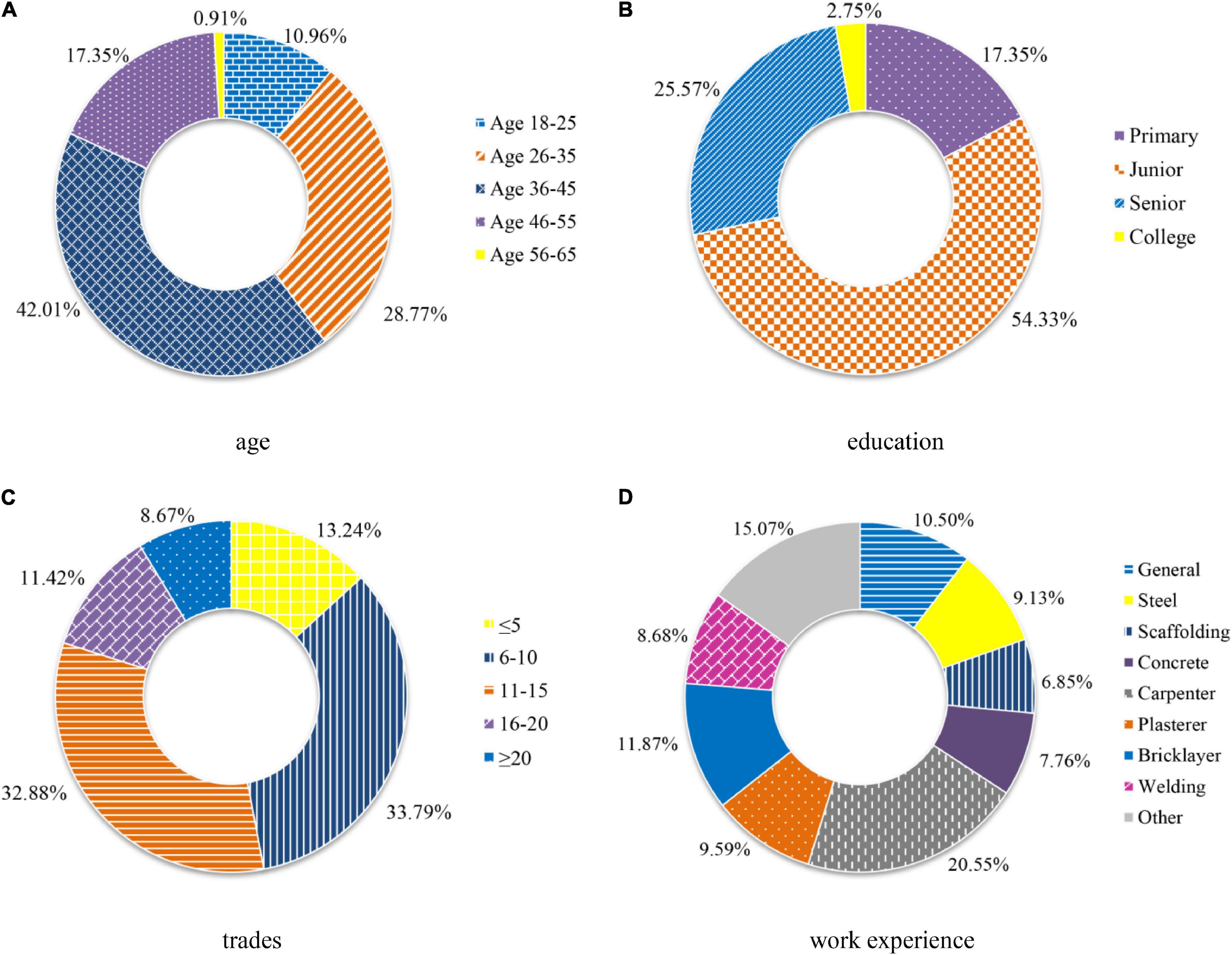
Figure 3. Demographic profiles of workers participated in the exploratory factor analysis (EFA) in terms of (A) age, (B) education, (C) trades, and (D) work experience.
Exploratory Factor Analysis
Following steps were performed firstly before the factor extraction process, including numerical conversion of reverse items, recording and scoring reverse items, and assigning new values to old ones. Then, the KMO and Bartlett test were examined to analyze a correlation between original variables, namely whether it was suitable for the factor analysis (Clark and Watson, 1995). The results showed that the KMO value was 0.902 and the significant level of Bartlett test was 0, it indicated an appropriateness of data for the factor analysis.
The scree test and eigenvalue (>1) recommended by Costello and Osborne (2005) were used in combination to decide the number of factors to be extracted (Costello and Osborne, 2005). The graph of eigenvalues in the scree test (Figure 4) was studied, and the break point of data where the curve flattened out was identified. Finally, three factors were clearly identified with the consideration of the criteria mentioned; the result was in accordance with the conceptual framework proposed in stage 1. Accordingly, a total of 12 items of the CWISC scale were retained for further analysis after removing six unbefitting items. For the clarity of presentation, factor loadings below 0.3 were not shown in Table 6 as done in the study of Man et al. (2019). The factor loadings of the 12 items belonging to three dimensions varied from 0.519 to 0.920, and each item had a unique contribution to one of these three factors. The eigenvalues of CSC, SSC, and PSC were 6.081, 1.216, and 1.111, respectively, these dimensions accounted for 70.075% of the total variance.
The reliability and validity of the scale were tested to demonstrate their effectiveness. Cronbach coefficient was used to measure the reliability of the questionnaire. In this stage, the overall Cronbach’s α of the scale with 12 items was 0.910, the three subscales also obtained excellent internal consistency following that a Cronbach’s alpha value above 0.70 was recommended to ensure data reliability (Kim et al., 2021). Cronbach’s α of CSC, SSC, and PSC reached 0.810, 0.902, and 0.770. As consequence, all 12 items derived from EFA were worth retaining to the next stage of scale validation.
Study 4
Methods
Participants and Procedure
For the verification of item-factor relationships (factor loadings) and the underlying dimensions of the instrument, CFA, one type of structural equation modeling (SEM) (Ullma, 2006), was conducted with a maximum likelihood method. Based on another sample of 156 construction workers, the factor structure derived from stage 3 was incorporated as a measurement model in CFA. This process played an important role in validating the hypothesized model and inspecting the reliability of the measurement. The location of the investigated cities was the same as that in stage 2, and identical distribution and scoring criteria of the questionnaire were employed in this stage. The statistical analysis of workers was depicted in Figure 5 with the same color and fill formats as Figure 3. There was no significant difference between the samples used in the two stages, since fluctuations for the proportion of each part were within 6% (Xie et al., 2021).
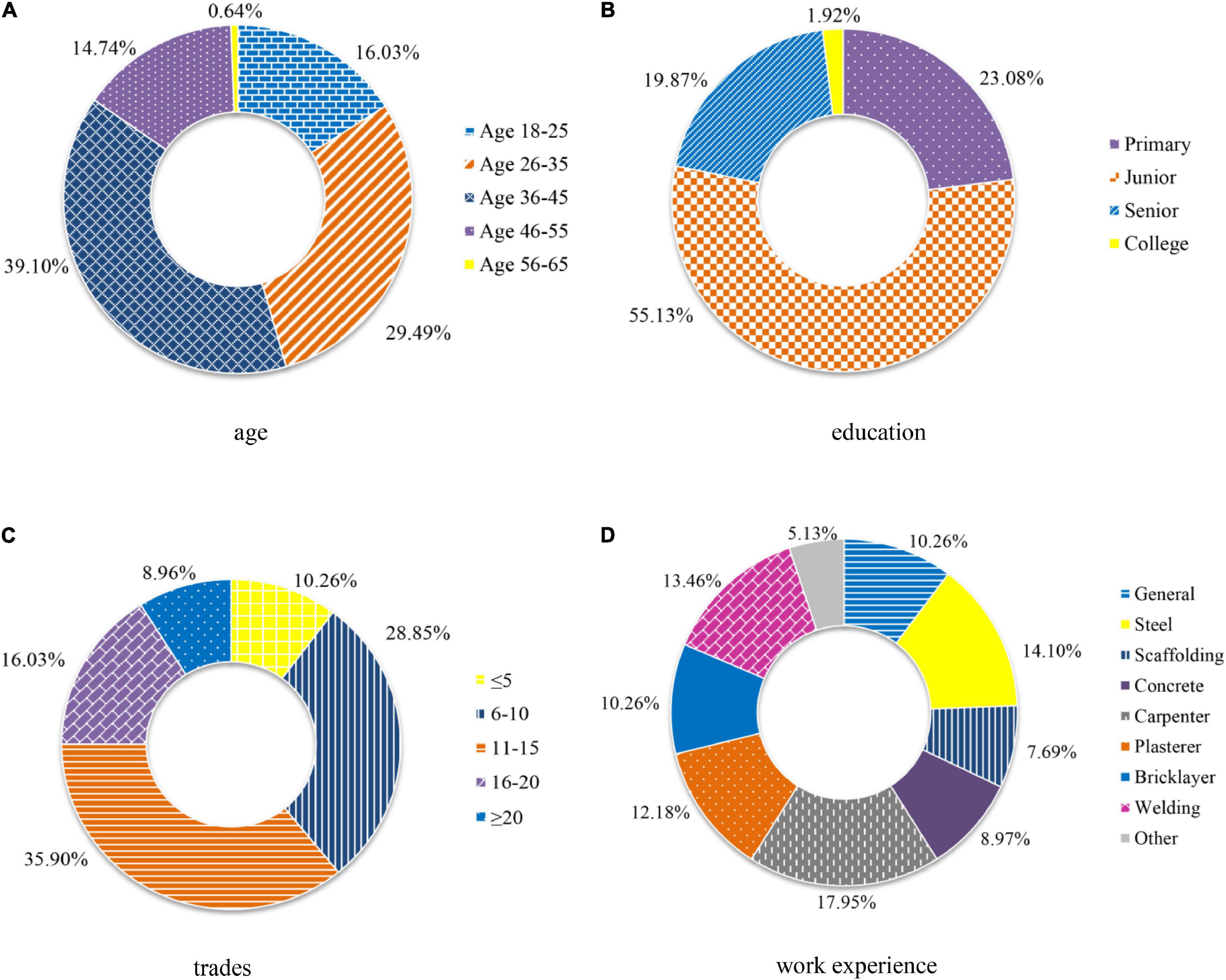
Figure 5. Demographic profiles of workers participated in the confirmatory factor analysis (CFA) in terms of (A) age, (B) education, (C) trades, and (D) work experience.
Data Analysis
Followed Crawford’s and Kelder’s suggestions of model fit indices, we reported the Chi-square value (χ2), root mean square error of approximation (RMSEA), comparative fit index (CFI), Tucker–Lewis’s goodness-of-fit index (TLI), and standardized root mean square residual (SRMR) to indicate the model-data fit (Hooper et al., 2008; Kline, 2011). Cronbach’s alpha for internal consistency reliability, composite reliability (C.R.), convergent validity, and discriminant validity were also assessed.
Results
Confirmatory Factor Analysis
The three-factor measurement model was tested as illustrated in Figure 6. The results revealed a good fit to data. The goodness-of-fit indices were adequate with χ2 = 68.738, χ2/df = 1.348, p = 0.049, CFI = 0.976, TLI = 0.968, RMSEA = 0.047, standardized RMR = 0.050, GFI = 0.930, and IFI = 0.976. The values of these goodness-of-fit statistics demonstrated an acceptable model fit (McDonald and Ho, 2002; Kline, 2011).
Reliability Assessment
Given that sufficient evidence for the integrity of the factor structure has emerged, its reliability was then assessed. Internal consistency reliability was used to describe the extent to which all items in the scale measured the same concept or construct (Tavakol and Dennick, 2011). With a criterion level of 0.7, Cronbach’s alpha was employed to measure internal consistency reliability of the scale (Man et al., 2019). The overall internal reliability of CWISC scale was 0.837, Cronbach’s α of subscales and C.R. were shown in Table 7. The results showed a range from 0.807 to 0.856 for Cronbach’s α of subscales, and a range from 0.810 to 0.858 of C.R., these indicated an acceptable consistency reliability as well as CR.
Validity Assessment
The final stage involved testing for convergent and discriminant validity of the final version of the CWISC scale. Convergent validity, which refers to a correlation between two or more scores on the scale, is designed to assess similar constructs (Chen and Tung, 2014). It can be determined by factor loadings and the average variance extracted (AVE) value for every construct (Fornell and Larcker, 1981). As shown in Table 7 and Figure 6, factor loadings of observed variables were significant between 0.69 and 0.84, the values of AVE were all greater than 0.5. Those statistics illustrated that the convergent validity of the CWISC scale was acceptable (Fornell and Larcker, 1981).
Discriminant validity refers to the extent to which the measure is indeed novel and not simply a reflection of few other variables (Churchill, 1979). The square root of the AVE value was adopted to assess the discriminant validity of the CWISC scale. As shown in Tables 7, 8, all square roots of AVE were greater than construct correlations, which implied discriminant validity to be acceptable (Fornell and Larcker, 1981). Ultimately, based on the processes presented earlier, the final CWISC scale with 12 items was generated.
Discussion
The prevalence of CWISC on construction sites and its limited understanding called for the conceptualization and quantification of a construct. Thus, this study presented the development and validation process of the CWISC scale in terms of its ability to measure the communicational characteristics, which were not easy to be detected and rewarded on construction sites. The final scale contained 12 items and three dimensions: CSC, SSC, and PSC. The obtained results indicated that the CWISC had a clear factor structure and adequate metric properties with good validity and reliability, the finding prepared an instrument to aid in understanding and estimating informal safety communication of workers on construction sites.
Construction workers’ informal safety communication demonstrated workers’ different types of informal safety communication under multiple motivations. As the first dimension, the measurement items of CSC reflected altruistic safety communication in both proactive and passive situations. For instance, proactive CSC was described by workers as “I will tell my workmates how to operate safely when finding him working unsafely,” while passive CSC was embodied as “I will tell him if I know when my workmates asking me about safety-related issues.” The proposal of proactive CSC was essentially in accordance with the measurement items involved in safety climate (Gao et al., 2017; Zhang et al., 2020) and SCB (Meng and Chan, 2020). As described about “interpersonal helping” in Table 2, those descriptions were all actions of initiating CSC. Moreover, the study further reported the passive CSC, which was proved to be another form of participation in altruism-actuated safety communication. This implied that when a worker was asked by coworkers for safety information, the altruistic motivation would facilitate him to respond, it contributed to create a virtuous cycle of SSC–CSC. Conversely, inability to obtain the required safety information will impair the willingness of workers to ask a safety-related question. Considering the discretion of CSC, the results also led to the need to explore incentives, even beyond the formal reward system, to increase workers’ positivity to join CSC.
The second dimension, SSC, was closely linked to workers’ own safety needs, which can be well explained by Maslow’s hierarchy of needs. The theory classified human needs into five grades from low to high, those were physiological needs, safety needs, belonging, esteem, and self-actualization (Maslow, 1943). It described the process of individual’s demand chasing, in which the realization of lower-level needs was a prerequisite for individuals to pursue needs at a higher level (Wahba and Bridwell, 1976; Hale et al., 2019). As identified in the second level, safety needs of construction workers was deemed to be primary, only when a worker fulfilled the expected safety requirements for personal and workplace safety, can other subsequent needs be pursued. Despite the fundamental safety needs have pushed SSC to the forefront, it was only mentioned in limited studies as the annotation in Table 2 “Calling friends on how to handle a work problem” (Allison and Kaminsky, 2017; Chen et al., 2021). More attention needs to be paid considering its priority among three subdimensions of CWISC.
Apparently, in view of the highest mean in three subdimensions and the support from the fundamental safety needs, SSC was evidenced to be the most basic form of safety communication. Moreover, SSC accounted for 50.68% of the total variance, which also indicated that it was a dominant factor. The opinion that workers were considered to be responsible for their own safety was in line with Didla’s exposition. In the course of his interviews, workers claimed that it was their duty to keep their own safety, they did not want to be hurt (Didla et al., 2009). However, nearly half of the workers interviewed in this study admitted that they hardly ever asked coworkers for safety information. When ambiguous safety information emerged at work, they felt feasible to follow their own work experiences, this tendency may put themselves into a dangerous situation. Being the least mentioned event during interviews (15), as well as receiving an unexpected low mean score (below 0.4) in the investigation, an urgent need to give particular concerns on exploring the underlying reasons behind workers’ experience-preferred operation is also stressed. A cognitive failure of a worker, which is caused by ambiguity or lacking of indispensable safety information, will ultimately lead to the occurrence of unsafe behaviors (Fang et al., 2016).
For the third dimension, PSC and the covered items were defined to evaluate workers’ representation on safety information sharing. The measurement items revolving around safety discussion were designed based on existing research, as “I feel comfortable discussing safety issues with my workmates” and “I would like to share my safety operation experience with my workmates.” Meanwhile, the result provided a well explanation for the dynamic discussion process under Cognitive Surplus and Herd Mentality. In the state of Cognitive Surplus, experienced workers are willing to share their safety-related knowledge in their rest time, this action was considered to be an important channel for the transmission of tacit knowledge within the crew (Matei, 2012). Additionally, unlike workers who initially engaged in safety discussion with the mindset of sharing information, the participation of some workers was detected to be an efficacy of Herd Mentality. Some workers declared that they joined in the discussion initially just because familiar workers were involved. With the enthusiasm and openness of the discussion gradually increased, they became willing to share their opinions. This phenomenon of conformity was in line with the inspiration from Liang’s research, in which workers’ safety violations were shown to be contagious within the crew (Liang et al., 2018). This led to the consideration on how to promote the positive effect of Herd Mentality through management interventions. In view of that, open safety discussion provides a shared understanding of expected behaviors and how procedures should be translated into work practices (Michael et al., 2006), efforts should be made to facilitate workers’ willing to participate in safety discussion as well as their positive attitude toward PSC.
All three types of CWISC can promote transferring and sharing of safety-related information within crews, they also contribute to the cultivation of risk management capability together with safety awareness of workers. The dynamic process of safety communication produces an important access to achieve self-safety management within the workers group, it further elicits the formation of a worker-centered adaptive system, by which the proactive safety management was expected to achieve. The development and cultivation of proactive self-management should be emphasized and applied in combination with passive management methods, such as the implementation of management interventions. The study is expected to draw attention to the importance of CWISC in follow-up studies.
Theoretical Implications
The CWISC framework and the corresponding scale developed in this article are expected to generate the following important theoretical implications. First, the findings of this study reflected the applicability of relevant theories in construction safety research, these provided new explanations for intra-team safety communication. Then, this study was an extension of previous research investigating the communication network in a safety context to increase our understanding on its composition. Following the basic attributes of organizational communication, such as the direction of information transmission and communication channels, the findings provided supportive evidence on the three types of CWISC from the perspective of individual motivation. In particular, a valuable source of information formed by the study provided richer insights into CWISC, these findings had a potential to highlight a disparity within these dimensions. Finally, an in-depth analysis of the construct was helpful to improve the theories of safety communication under the construction background. Theoretically, the CWISC scale, as a multi-tested measurement tool, was a necessary basis for derivative research. It is expected to contribute to the completion of more research focusing on safety communication among workers.
Practical Implications
Apart from theoretical implications, this research also generated the following practical implications. Initially, through the adoption of the proposed CWISC scale, managerial benefits may be obtained in developing and implementing effective safety management strategies. The scale can serve as an instrument to assess the performances and tendency of workers’ safety communication, the results may help in identifying weaknesses in safety communication. Consequently, wasted management costs could be avoided by selecting and implementing the targeted incentive programs. Further, the practice issue of poor performances within workers’ responsibilities was identified and highlighted. The authors believe that there are a mixed set of reasons for the poor SSC on construction sites, such information will hopefully increase the attention of managers and researchers to the problem. Finally, the management intervention of setting up model workers to inspire coworkers’ passions for safe communication is recommended to be carried out. It is expected that the CWISC scale could lead to a diverse approach in practice to authenticate and augment workers’ safety communication performances.
Limitations and Future Research
Despite contributions of the proposed CWISC framework and its corresponding scale, its limitations must be recognized and future research should be conducted. Although the CWISC scale is expected to have applicability across different countries, the findings of this study were limited to the construction industry in China, it is necessary to further verify its validity in other countries. Then, given the difficulty and limitation of data acquisition, 219 samples and 156 samples were used in EFA and CFA, respectively; a larger sample size should be employed in follow-up studies to validate the developed scale. In addition, there are many sociodemographic factors (e.g., education, work experience, and trade) that could affect safety communication behaviors. It is worthwhile to expand research in this area to obtain a full picture of the CWISC phenomenon. Finally, the study gave a particular focus on CWISC itself to dissect its classification and relative characteristics, efforts should be made in future studies to explore its facilitators and inhibitors. The predictability of CWISC on safety culture or other indicators of safety performance is also suggested for examination. Considering the important role of CWISC on safety performance in the context of construction, abundant research will provide valuable references for the development of management measures.
Conclusion
Construction workers’ informal safety communication has always been unavoidable on construction sites. By conducting a four-phase deductive–inductive study with a qualitative and quantitative analysis, a comprehensive measurement instrument was developed and validated, the CWISC scale with 12 items was designed to assess workers’ communication performances on construction sites. In addition, three dimensions of CWISC, CSC, SSC, and PSC, were identified. Given the lack of concern on exploring the framework and measurement scale of CWISC, it may provide a distinct contribution to theory building and assessment practice on intra-crew safety communication. Moreover, the theoretical and practical implications will draw the attention of managers and researchers to consider the management issues related to it. Despite the useful results of this study, additional works should be carried out to further validate the scale under different backgrounds; its limitations should also be addressed in the future. We expect that the study can lead to diverse research in which the three-dimensional construct of CWISC will be taken into account.
Data Availability Statement
The raw data supporting the conclusions of this article will be made available by the authors, without undue reservation.
Ethics Statement
Ethical review and approval was not required for the study on human participants in accordance with the local legislation and institutional requirements. Written informed consent for participation was not required for this study in accordance with the national legislation and the institutional requirements.
Author Contributions
WC and YS put forward the research idea and promoted the implementation and completion of this research. SZ, HL, and HX supported the data collection. WC involved in statistical analysis, the interpretation of the results, and composing the first draft. HL and HX gave help to further optimize and complete this manuscript. All authors contributed to this article and approved the submitted version.
Funding
This work was supported by the National Research Program of China (Grant No. 2021YFF0602002-02), the National Natural Science Foundation of China (Grant No. 72002010), Beijing Municipal Natural Science Foundation (Grant No. 9214025), and The Fundamental Research Funds for the Central Universities (Grant No. 2020RCW007).
Conflict of Interest
The authors declare that the research was conducted in the absence of any commercial or financial relationships that could be construed as a potential conflict of interest.
Publisher’s Note
All claims expressed in this article are solely those of the authors and do not necessarily represent those of their affiliated organizations, or those of the publisher, the editors and the reviewers. Any product that may be evaluated in this article, or claim that may be made by its manufacturer, is not guaranteed or endorsed by the publisher.
References
Albert, A., and Hallowell, M. R. (2017). Modeling the role of social networks on hazard recognition and communication. Pract. Period. Struct. Design Construct. 22:04017016. doi: 10.1061/(ASCE)SC.1943-5576.0000337
Allison, L., and Kaminsky, J. (2017). Safety communication networks: females in small work crews. J. Construct. Eng. Manag. 143:04017050. doi: 10.1061/(ASCE)CO.1943-7862.0001344
Alsamadani, R., Hallowell, M., and Javernick-Will, A. N. (2013). Measuring and modelling safety communication in small work crews in the US using social network analysis. Construct. Manag. Econ. 31, 568–579. doi: 10.1080/01446193.2012.685486
Beus, J. M., Payne, S. C., Arthur, W., and Munoz, G. J. (2019). The development and validation of a cross-industry safety climate measure: resolving conceptual and operational issues. J. Manag. 45, 1987–2013. doi: 10.1177/0149206317745596
Chan, A. P. C., Javed, A. A., Lyu, S., and Hon, C. K. H. (2016). Strategies for improving safety and health of ethnic minority construction workers. J. Construct. Eng. Manag. 142, 1–10. doi: 10.1061/(ASCE)CO.1943-7862.0001148
Chen, M. F., and Tung, P. J. (2014). Developing an extended theory of planned behavior model to predict consumers’ intention to visit green hotels. Int. J. Hospital. Manag. 36, 221–230. doi: 10.1016/j.ijhm.2013.09.006
Chen, S. C. (2017). Paternalistic leadership and cabin crews’ upward safety communication: the motivation of voice behaviour. J. Air. Transp. Manage. 62, 44–53.
Chen, W. T., Merrett, H. C., Huang, Y. H., Bria, T. A., and Lin, Y. H. (2021). Exploring the relationship between safety climate and worker safety behavior on building construction sites in Taiwan. Sustainability 13:2226. doi: 10.3390/su13063326
Choi, B., Ahn, S., and Lee, S. (2017). Construction workers’ group norms and personal standards regarding safety behavior: social identity theory perspective. J. Manag. Eng. 33:04017001. doi: 10.1061/(ASCE)ME.1943-5479.0000511
Churchill, G. A. Jr. (1979). A paradigm for developing better measures of marketing constructs. J. Mark. Res. 16, 64–73. doi: 10.1177/002224377901600110
Cigularov, K. P., Chen, P. Y., and Rosecrance, J. (2010). The effects of error management climate and safety communication on safety: a multi-level study. Accid Anal. Prev. 42, 1498–1506. doi: 10.1016/j.aap.2010.01.003
Clark, L. A., and Watson, D. (1995). Constructing validity: basic issues in objective scale development. Psychol. Assess. 7, 309–319. doi: 10.1037/1040-3590.7.3.309
Costello, A. B., and Osborne, J. (2005). Best practices in exploratory factor analysis: four recommendations for getting the most from your analysis. Pract. Assess. Res. Eval. 10:7. doi: 10.7275/jyj1-4868
Deng, Y. L., Guo, H. L., Meng, M., Zhang, Y., and Pei, S. (2020). Exploring the effects of safety climate on worker’s safety behavior in subway operation. Sustainability 12:8310. doi: 10.3390/su12208310
Didla, S., Mearns, K., and Flin, R. (2009). Safety citizenship behaviour: a proactive approach to risk management. J. Risk Res. 12, 475–483. doi: 10.3390/ijerph18052685
Evans, B., Glendon, A. I., and Creed, P. A. (2007). Development and initial validation of an Aviation Safety Climate Scale. J. Saf. Res. 38, 675–682. doi: 10.1016/j.jsr.2007.09.005
Fang, D. P., Zhao, C., and Zhang, M. (2016). A cognitive model of construction workers’ unsafe behaviors. J. Construct. Eng. Manag. 142:04016039. doi: 10.1061/(asce)co.1943-7862.0001118
Farooq, R. (2016). Role of structural equation modeling in scale development. J. Adv. Manag. Res. 13, 75–91. doi: 10.1108/JAMR-05-2015-0037
Fischbach, K., Gloor, P. A., and Schoder, D. (2009). Analysis of informal communication networks–a case study. Bus. Inform. Syst. Eng. 1, 140–149. doi: 10.1007/s12599-008-0018-z
Fornell, C., and Larcker, D. F. (1981). Evaluating structural equation models with unobservable variables and measurement error. J. Mark. Res. 18, 39–50. doi: 10.1177/002224378101800104
Gao, R., Chan, A. P. C., Utama, P., and Zahoor, H. (2017). Workers’ perceptions of safety climate in international construction projects: effects of nationality, religious belief, and employment mode. J. Construct. Eng. Manag. 143:4016117. doi: 10.1061/(asce)co.1943-7862.0001226
Hale, A. J., Ricotta, D. N., Freed, J., Smith, C. C., and Huang, G. C. (2019). Adapting Maslow’s hierarchy of needs as a framework for resident wellness. Teach. Learn. Med. 31, 109–118. doi: 10.1080/10401334.2018.1456928
Hallowell, M. R. (2012). Safety-knowledge management in American construction organizations. J. Manag. Eng. 28, 203–211. doi: 10.1061/(ASCE)ME.1943-5479.0000067
Hinkin, T. R. (1998). A brief tutorial on the development of measures for use in survey questionnaires. Organ. Res. Methods 1, 104–121. doi: 10.1177/109442819800100106
Ho, C. M. F. (2013). Communication makes a corporate code of ethics effective: lessons from Hong Kong. J. Construct. Eng. Manage. 139, 128–137. doi: 10.1061/(ASCE)CO.1943-7862.0000568
Hooper, D., Coughlan, J., and Mullen, M. R. (2008). Structural equation modelling: guidelines for determining model fit. Electron. J. Bus. Res. Methods 6, 53–60. doi: 10.3109/03005364000000039
Huang, Y.-H., Sinclair, R. R., Lee, J., McFadden, A. C., Cheung, J. H., Murphy, L. A., et al. (2018). Does talking the talk matter? Effects of supervisor safety communication and safety climate on long-haul truckers’ safety performance. Accident Anal. Prevent. 117, 357–367. doi: 10.1016/j.aap.2017.09.006
Itzkovich, Y. (2021). Constructing and validating students’ psychological contract violation scale. Front. Psychol. 12:685468. doi: 10.3389/fpsyg.2021.685468
Jian, G., Shi, X., and Dalisay, F. (2014). Leader–member conversational quality: scale development and validation through three studies. Manag. Commun. Q. 28, 375–403. doi: 10.1177/0893318914533201
Jolliffe, I. T., and Cadima, J. (2016). Principal component analysis: a review and recent developments. Philos. Trans. R. Soc. a-Mathematical Phys. Eng. Sci. 374:20150202. doi: 10.1098/rsta.2015.0202
Kaskutas, V., Buckner-Petty, S., Dale, A. M., Gaal, J., and Evanoff, B. A. (2016). Foremen’s intervention to prevent falls and increase safety communication at residential construction sites. Am. J. Industrial Med. 59, 823–831. doi: 10.1002/ajim.22597
Kim, T.-E., Sydnes, A. K., and Batalden, B. M. (2021). Development and validation of a safety leadership Self-Efficacy Scale (SLSES) in maritime context. Saf. Sci. 134:105031. doi: 10.1016/j.ssci.2020.105031
Kincl, L. D., Hess, J. A., Weeks, D. L., Vaughan, A., and Anton, D. (2020). Efficacy of text messaging apprentices to reinforce ergonomics and safety voice training. J. Saf. Res. 74, 35–43. doi: 10.1016/j.jsr.2020.04.007
Kines, P., Andersen, L. P., Spangenberg, S., Mikkelsen, K. L., Dyreborg, J., Zohar, D., et al. (2010). Improving construction site safety through leader-based verbal safety communication. J. Saf. Res. 41, 399–406. doi: 10.1016/j.jsr.2010.06.005
Kline, R. B. (2011). Principles and practice of structural equation modeling. J. Am. Stat. Assoc. 101, 1941–1947. doi: 10.1002/0470013192.bsa655
Lestari, F., Sunindijo, R. Y., Loosemore, M., Kusminanti, Y., and Widanarko, B. (2020). A safety climate framework for improving health and safety in the Indonesian construction industry. Int. J. Environ. Res. Public Health 17:7642. doi: 10.3390/ijerph17207462
Li, H., Li, X., Luo, X., and Siebert, J. (2017). Investigation of the causality patterns of non-helmet use behavior of construction workers. Automat. Construct. 80, 95–103. doi: 10.1016/j.autcon.2017.02.006
Li, S., Wu, X., Wang, X., and Hu, S. (2020). Relationship between social capital, safety competency, and safety behaviors of construction workers. J. Constr. Eng. Manage. 146:04020059. doi: 10.1061/(ASCE)CO.1943-7862.0001838
Liang, H., Lin, K.-Y., Zhang, S., and Su, Y. (2018). The impact of coworkers’ safety violations on an individual worker: a social contagion effect within the construction crew. Int. J. Environ. Res. Public Health 15:773. doi: 10.3390/ijerph15040773
Liang, H., and Shi, X. (2021). Exploring the structure and emerging trends of construction health management: a bibliometric review and content analysis. Eng. Construct. Architectural Manag.
Liang, H., and Zhang, S. (2019). Impact of supervisors’ safety violations on an individual worker within a construction crew. Saf. Sci. 120, 679–691. doi: 10.1016/j.ssci.2019.08.014
Liao, P., Jiang, L., Liu, B., and Chen, C. (2014). A cognitive perspective on the safety communication factors that affect worker behavior. J. Build. Construct. Plann. Res. 2:49980. doi: 10.4236/jbcpr.2014.23017
Lingard, H., Pirzadeh, P., and Oswald, D. (2019). Talking safety: health and safety communication and safety climate in subcontracted construction workgroups. J. Construct. Eng. Manag. 145:11. doi: 10.1061/(asce)co.1943-7862.0001651
Man, S. S., Chan, A. H. S., and Alabdulkarim, S. (2019). Quantification of risk perception: development and validation of the construction worker risk perception (CoWoRP) scale. J. Saf. Res. 71, 25–39. doi: 10.1016/j.jsr.2019.09.009
Maslow, A. H. (1943). A theory of human motivation. Psychol. Rev. 50, 370–396. doi: 10.1037/h0054346
McDonald, R. P., and Ho, M. (2002). Principles and practice in reporting structural equation analyses. Psychol. Methods. 7, 64–82. doi: 10.1037//1082-989X.7.1.64
Meng, X., and Chan, A. H. (2020). Demographic influences on safety consciousness and safety citizenship behavior of construction workers. Saf. Sci. 129:104835. doi: 10.1016/j.ssci.2020.104835
Michael, J. H., Guo, Z. G., Wiedenbeck, J. K., and Ray, C. D. (2006). Production supervisor impacts on subordinates’ safety outcomes: an investigation of leader-member exchange and safety communication. J. Saf. Res. 37, 469–477. doi: 10.1016/j.jsr.2006.06.004
Pandit, B., Albert, A., and Patil, Y. (2020). Developing construction hazard recognition skill: leveraging safety climate and social network safety communication patterns. Construct. Manag. Econ. 38, 640–658. doi: 10.1080/01446193.2020.1722316
Parker, S. K., Axtell, C. M., and Turner, N. (2001). Designing a safer workplace: importance of job autonomy, communication quality, and supportive supervisors. J. Occupational Health Psychol. 6, 211–228. doi: 10.1037/1076-8998.6.3.211
Polit, D. F., and Beck, C. T. (2006). The content validity index: are you sure you know what’s being reported? Critique and recommendations. Res. Nurs. Health 29, 489–497. doi: 10.1002/nur.20147
Rajendran, S., Gambatese, J. A., and Behm, M. G. (2009). Impact of green building design and construction on worker safety and health. J. Construct. Eng. Manag. 135, 1058–1066. doi: 10.1061/(ASCE)0733-93642009135:101058
Shuen, Y. S., and Wahab, S. R. A. (2016). The mediating effect of safety culture on safety communication and human factor accident at the workplace. Asian Soc. Sci. 12, 12–142. doi: 10.5539/ass.v12n12p127
Su, Y., Cong, W., and Lian, H. (2019). The impact of supervisor–worker relationship on workers’ safety violations: a modified theory of planned behaviour. J. Civil Eng. Manag. 25, 631–645. doi: 10.3846/jcem.2019.10439
Tang, F., Mu, J., and Thomas, E. F. (2015). Who knows what in NPD teams: communication context, mode, and task contingencies. J. Prod. Innovat. Manag. 32, 404–423. doi: 10.1111/jpim.12226
Tavakol, M., and Dennick, R. (2011). Making sense of Cronbach’s alpha. Int. J. Med. Educ. 2:53. doi: 10.5116/ijme.4dfb.8dfd
Tucker, S., Chmiel, N., Turner, N., Hershcovis, M. S., and Stride, C. B. (2008). Perceived organizational support for safety and employee safety voice: the mediating role of coworker support for safety. J. Occupat. Health Psychol. 13:319. doi: 10.1037/1076-8998.13.4.319
Turner, N., Chmiel, N., Hershcovis, M. S., and Walls, M. (2010). Life on the line: job demands, perceived co-worker support for safety, and hazardous work events. J. Occupat. Health Psychol. 15, 482–493. doi: 10.1037/a0021004
Ullma, J. (2006). Structural equation modeling: reviewing the basics and moving forward. J. Pers. Assess. 87, 35–50. doi: 10.1207/s15327752jpa8701_03
Vecchio-Sadus, A. M. (2007). Enhancing safety culture through effective communication. Saf. Sci. Monit. 11, 1–10.
Wahba, M. A., and Bridwell, L. G. (1976). Maslow reconsidered: a review of research on the need hierarchy theory. Organ. Behav. Hum. Perform. 15, 212–240. doi: 10.1016/0030-5073(76)90038-6
Walker, A. (2010). The development and validation of a psychological contract of safety scale. J. Saf. Res. 41, 315–321. doi: 10.1016/j.jsr.2010.06.002
Wu, G., Liu, C., Zhao, X., and Zuo, J. (2017). Investigating the relationship between communication-conflict interaction and project success among construction project teams. Int. J. Project Manag. 35, 1466–1482. doi: 10.1016/j.ijproman.2017.08.006
Xie, C. W., Zhang, J. C., and Morrison, A. M. (2021). Developing a scale to measure tourist perceived safety. J. Travel Res. 60, 1232–1251. doi: 10.1177/0047287520946103
Yang, D., He, Q., and Cui, Q. (2018). Organizational citizenship behavior in construction megaprojects. J. Manag. Eng. 34:04018017. doi: 10.1061/(ASCE)ME.1943-5479.0000614
Yates, J., and Orlikowski, W. J. (1992). Genres of organizational communication: a structurational approach to studying communication and media. Acad. Manag. Rev. 17, 299–326.
Zaira, M. M., and Hadikusumo, B. (2017). Structural equation model of integrated safety intervention practices affecting the safety behaviour of workers in the construction industry. Saf. Sci. 98, 124–135. doi: 10.1016/j.ssci.2017.06.007
Zamanzadeh, V., Ghahramanian, A., Rassouli, M., Abbaszadeh, A., Alavi-Majd, H., Nikanfar, A. R., et al. (2015). Design and implementation content validity study: development of an instrument for measuring patient-centered communication. J. Caring Sci. 4, 165–178. doi: 10.15171/jcs.2015.017
Zhang, P. Y., Li, N., Jiang, Z., Fang, D., and Anumba, C. J. (2019). An agent-based modeling approach for understanding the effect of worker-management interactions on construction workers’ safety-related behaviors. Automat. Construct. 97, 29–43. doi: 10.1016/j.autcon.2018.10.015
Zhang, R. P., Lingard, H., and Oswald, D. (2020). Impact of supervisory safety communication on safety climate and behavior in construction workgroups. J. Construct. Eng. Manag. 146:04020089. doi: 10.1061/(ASCE)CO.1943-7862.0001881
Zhou, Q., Fang, D., and Wang, X. (2008). A method to identify strategies for the improvement of human safety behavior by considering safety climate and personal experience. Saf. Sci. 46, 1406–1419. doi: 10.1016/j.ssci.2007.10.005
Zhou, S. G., Hou, Y. F., Liu, D., Xu, D., and Zhang, X. (2021). Psychotherapy style scale: development and validation. Front. Psychol. 12:543989. doi: 10.3389/fpsyg.2021.543989
Keywords: informal safety communication, scale development, intrinsic motivation, factor analysis, Chinese
Citation: Cong W, Xue H, Liang H, Su Y and Zhang S (2022) Informal Safety Communication of Construction Workers: Conceptualization and Scale Development and Validation. Front. Psychol. 13:825975. doi: 10.3389/fpsyg.2022.825975
Received: 30 November 2021; Accepted: 07 February 2022;
Published: 17 March 2022.
Edited by:
Ruoyu Jin, London South Bank University, United KingdomReviewed by:
Simon L. Albrecht, Deakin University, AustraliaFederica Caffaro, Roma Tre University, Italy
Copyright © 2022 Cong, Xue, Liang, Su and Zhang. This is an open-access article distributed under the terms of the Creative Commons Attribution License (CC BY). The use, distribution or reproduction in other forums is permitted, provided the original author(s) and the copyright owner(s) are credited and that the original publication in this journal is cited, in accordance with accepted academic practice. No use, distribution or reproduction is permitted which does not comply with these terms.
*Correspondence: Yikun Su, eWtzdUBuZWZ1LmVkdS5jbg==
 Weiyi Cong
Weiyi Cong Hong Xue
Hong Xue Huakang Liang3
Huakang Liang3 Yikun Su
Yikun Su